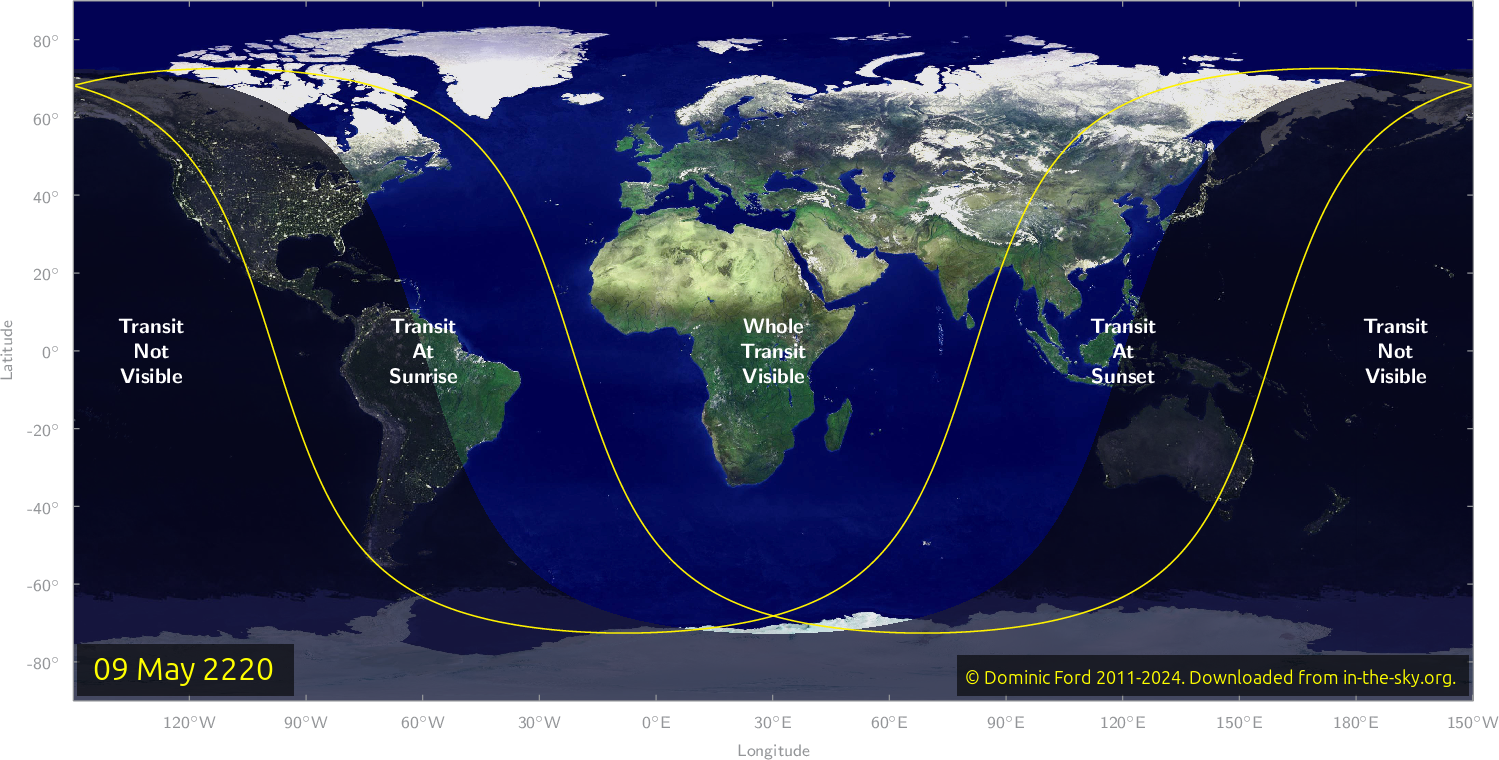Roughly 13–14 times each century, Mercury passes directly in front of the Sun, casting a small black silhouette in front of the solar disk for a few hours. Such a transit will occur on 9 May 2220, lasting from 00:22 until 05:30 PDT.
Between those times, the transit will be visible from anywhere on Earth, providing the Sun is above the horizon, including from Asia, Russia, Africa, the Americas, Europe and Antarctica.
Mercury last transited the Sun in November 2210, and its next transit will be in November 2223.
The simulation to the right shows the path that Mercury will take across the Sun's disk, drawn to scale. The Sun is more than 280 times larger than Mercury, and so the latter appears as a very small black speck in comparison to the Sun's disk.
By default, the simulation is drawn with respect the local vertical in South El Monte (Zenith up), matching how the Sun would appear when viewed through some suitably filtered telescope or a solar projection unit. Viewing the Sun through any optical instrument is incredibly dangerous, however, and tips for doing so safely are given below.
The compass within the simulation shows the direction of celestial north relative to the local vertical. You can orientate the simulation with celestial north orientated uppermost by selecting the option North up. Because Mercury is so far away, its path across the Sun is almost identical regardless of your location on Earth, though the orientation of your local vertical will differ.
Selecting the option Diagram of Mercury's path will produce a static display of the Mercury's path through the course of the transit.
The lower panel of the simulation shows the Sun's position relative to the local horizon in South El Monte.
Planetary alignment
Mercury orbits the Sun once every 88 days, completing just over four revolutions around the Sun for every one that the Earth completes. This means that it regularly overtakes the Earth in its orbit, and at such times the two planets lie side-by-side in their respective orbits.
This alignment is called inferior solar conjunction and occurs once every 116 days – a period called Mercury's synodic period. It takes place as Mercury moves from the evening sky into the morning sky. Even though Mercury invariably passes very close to the Sun at these times, it rarely passes exactly in front of the Sun's disk.
Mercury orbits the Sun in a slightly different plane from the Earth: its orbit is tipped up at an angle of 7° relative to Earth's orbit. The diagram below show this inclination of Mercury's orbit (not drawn to scale), with a grid representing the plane of the ecliptic – the plane in which the Earth orbits in Sun.

Mercury spends much of its time significantly above or below the plane of the Earth's orbit, and at such times it cannot pass directly in front of the Sun. If it passes inferior conjunction at such a time, it will appear to pass to the side of the Sun.
Mercury can only pass in front of the Sun if it passes inferior conjunction while it is also very close to the Earth–Sun plane. It crosses through this plane twice on each orbit around the Sun, roughly once every 44 days, at the points on the left and right sides of the diagram above. These points are called the nodes of Mercury's orbit.
The nodes of Mercury's orbit lie alongside the points along the Earth's orbit that we pass on around May 8 and November 10 each year. Consequently, transits of Mercury can only ever occur within a few days of these two possible dates.
Due to the precession of the equinoxes, these two dates advance through the year at a rate of roughly one day every 100 years.
This requirement for Mercury to pass one of the nodes of its orbit at the same time that is also passes inferior conjunction is met on average only once every 7–8 years, though transits do not occur at regular intervals.
Each time, Mercury can be seen to pass in front of the Sun from any location where the Sun is above the horizon at the time.

Further reading
For more information about safely observing the Sun, we recommend Lee Macdonald's excellent book How to Observe the Sun Safely , published by Springer in 2012.
The position of Mercury at the moment of closest approach to the centre of the Sun's disk will be:
The coordinates above are given in J2000.0.
Next/previous transits
| « Previous | Next » | |||
| Visible from the Contiguous United States | Worldwide | Worldwide | Visible from the Contiguous United States | |
| 12 Nov 2190 | 09 Nov 2210 | Transits of Mercury | 12 Nov 2223 | 12 May 2233 |
| 12 Nov 2190 | 09 Nov 2210 | Transits | 12 Nov 2223 | 12 May 2233 |
The sky on 7 Jan 2026
| The sky on 7 January 2026 | ||||||||||||||||||||||||||||||||||
|
76% 18 days old |
All times shown in PST.
|
|||||||||||||||||||||||||||||||||
Warning
Never attempt to point a pair of binoculars or a telescope at an object close to the Sun. Doing so may result in immediate and permanent blindness.
Source
The circumstances of this event were computed using the DE430 planetary ephemeris published by the Jet Propulsion Laboratory (JPL).
This event was automatically generated by searching the ephemeris for planetary alignments which are of interest to amateur astronomers, and the text above was generated based on an estimate of your location.
Related news
| 09 May 2220 | – Transit of Mercury |
| 05 Jun 2220 | – Mercury at greatest elongation west |
| 11 Jun 2220 | – Mercury at highest altitude in morning sky |
| 06 Aug 2220 | – Mercury at highest altitude in evening sky |
Image credit
© edhiker, November 2006.
